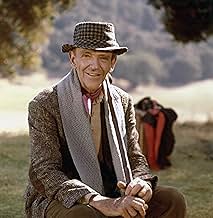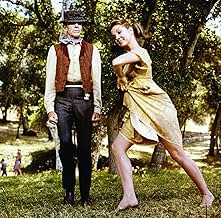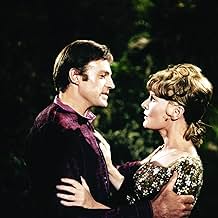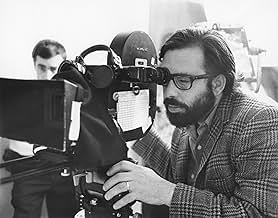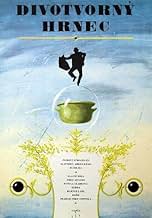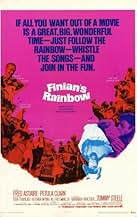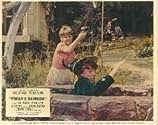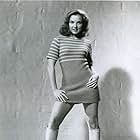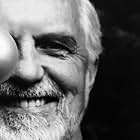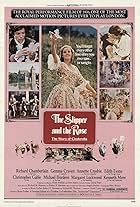An Irish immigrant and his daughter move into a town in the American South with a magical piece of gold that will change people's lives, including a struggling farmer and African American ci... Read allAn Irish immigrant and his daughter move into a town in the American South with a magical piece of gold that will change people's lives, including a struggling farmer and African American citizens threatened by a bigoted politician.An Irish immigrant and his daughter move into a town in the American South with a magical piece of gold that will change people's lives, including a struggling farmer and African American citizens threatened by a bigoted politician.
- Nominated for 2 Oscars
- 1 win & 9 nominations total
Brenda Arnau
- Sharecropper 'Necessity'
- (uncredited)
Charles Carter
- Sharecropper
- (uncredited)
Sterling Clark
- Sharecropper
- (uncredited)
Robert Cleaves
- Geologist
- (uncredited)
Robert Cole
- Sharecropper
- (uncredited)
Willie Covan
- Sharecropper
- (uncredited)
Evelyn Dutton
- Sharecropper
- (uncredited)
Featured reviews
"Finian's Rainbow" (1968) is one of the few films I saw three times in the theater, and since repeat viewings are normally not my thing it must have made some connection or maybe I just enjoyed watching Barbara Hancock dance. Despite this I agree with most of the critical comments about portions of the film.
Unfortunately it was assembled as a 145 minute "roadshow" musical; these were overlong spectaculars which depended less on the charm of the performers (think 1930's) than on pre-sold event marketing (unnecessary, pretentious, overscale, and distracting production values; souvenir programs; etc.). Right around the time of its release these mega-productions were leading many of the studios to financial ruin. Warner Brothers took a hit from this one; box office was bad but fortunately Coppola worked cheap and had cranked this out on the back-lot with a relatively modest budget.
Trim about 30 minutes from the film and you would have a much better production. There is a lot of stuff here that is supposed to be fun and just doesn't make it. Fortunately there are some real gems sandwiched throughout the film.
Think bi-racial "Lil Abner" (1959) with a touch of "The Wizard of Oz" (1939). The Oz connection comes from lyricist E. Y. Harburg, the guy who gave us "If I Were the King of the Forest". There are enough such silly songs to make up for toughing out the musical clunker moments. Tommy Steele absolutely shines doing this material (insert Bert Lahr here) .
Nothing wrong with the performances of Fred Astaire or Petula Clark either. And its not just his dancing and her singing, they both achieve excellent characterizations. Astaire at 70 does not look much different facially than Astaire at 30. But this time instead of a physically unlikely love interest he plays a warm old man still chasing a dream, and it's a much better fit. Clark does an excellent Debbie Reynolds and more than holds her own through the production.
Unfortunately there is little good to say about the casting of Don Francks as Petula's love interest and Hancock's older brother. Most likely Coppola felt that the film needed a relatively hip looking guy in place of a Gordon MacRae type. But Francks comes off as more of an oily hotshot; the kind of guy who would proposition your 14 year-old sister.
The plot has Finian and his daughter coming to Kentucky to bury a crock of gold he has stolen from a leprechaun back in Ireland. Finian believes that he can produce some kind of synergy by getting the gold within close range of Ft. Knox. They end up in a racially mixed Dogpatch named Rainbow Valley, where blacks and whites work side-by-side as tobacco sharecroppers. There is considerable intrigue involving the local racist political hacks, a new strain of mentholated tobacco being developed by a George Washington Carver type (nicely played by Al Freeman Jr.), back taxes on the sharecropping collective, romance, and a leprechaun who is slowly becoming human.
Barbara Hancock, a young but quite accomplished ballet dancer, is fetching as "Susan the Silent" (who dances instead of talking). Coppola adds a lot of nice lyrical moments by showcasing her dancing. It is said that Astaire resented her being cast instead of an older dancer he recommended. They are not paired in any number, a failure conspicuous by its absence.
The widescreen DVD looks great and the Coppola commentary is surprisingly interesting.
Then again, what do I know? I'm only a child.
Unfortunately it was assembled as a 145 minute "roadshow" musical; these were overlong spectaculars which depended less on the charm of the performers (think 1930's) than on pre-sold event marketing (unnecessary, pretentious, overscale, and distracting production values; souvenir programs; etc.). Right around the time of its release these mega-productions were leading many of the studios to financial ruin. Warner Brothers took a hit from this one; box office was bad but fortunately Coppola worked cheap and had cranked this out on the back-lot with a relatively modest budget.
Trim about 30 minutes from the film and you would have a much better production. There is a lot of stuff here that is supposed to be fun and just doesn't make it. Fortunately there are some real gems sandwiched throughout the film.
Think bi-racial "Lil Abner" (1959) with a touch of "The Wizard of Oz" (1939). The Oz connection comes from lyricist E. Y. Harburg, the guy who gave us "If I Were the King of the Forest". There are enough such silly songs to make up for toughing out the musical clunker moments. Tommy Steele absolutely shines doing this material (insert Bert Lahr here) .
Nothing wrong with the performances of Fred Astaire or Petula Clark either. And its not just his dancing and her singing, they both achieve excellent characterizations. Astaire at 70 does not look much different facially than Astaire at 30. But this time instead of a physically unlikely love interest he plays a warm old man still chasing a dream, and it's a much better fit. Clark does an excellent Debbie Reynolds and more than holds her own through the production.
Unfortunately there is little good to say about the casting of Don Francks as Petula's love interest and Hancock's older brother. Most likely Coppola felt that the film needed a relatively hip looking guy in place of a Gordon MacRae type. But Francks comes off as more of an oily hotshot; the kind of guy who would proposition your 14 year-old sister.
The plot has Finian and his daughter coming to Kentucky to bury a crock of gold he has stolen from a leprechaun back in Ireland. Finian believes that he can produce some kind of synergy by getting the gold within close range of Ft. Knox. They end up in a racially mixed Dogpatch named Rainbow Valley, where blacks and whites work side-by-side as tobacco sharecroppers. There is considerable intrigue involving the local racist political hacks, a new strain of mentholated tobacco being developed by a George Washington Carver type (nicely played by Al Freeman Jr.), back taxes on the sharecropping collective, romance, and a leprechaun who is slowly becoming human.
Barbara Hancock, a young but quite accomplished ballet dancer, is fetching as "Susan the Silent" (who dances instead of talking). Coppola adds a lot of nice lyrical moments by showcasing her dancing. It is said that Astaire resented her being cast instead of an older dancer he recommended. They are not paired in any number, a failure conspicuous by its absence.
The widescreen DVD looks great and the Coppola commentary is surprisingly interesting.
Then again, what do I know? I'm only a child.
The film version of "Finian's Rainbow" was conceived at a time when the public's interest in movie musicals was on the wane; in fact, in light of the poor critical reception accorded "Camelot" the year before, studio head Jack Warner would have been content to pull the plug on what he perceived as another sure-fire disaster. To an extent, his feelings were justified - what had been a daringly provocative look at racial strife in the deep American South as seen through the eyes of a scheming Irishman and his less-than-supportive daughter when it debuted on Broadway in 1947 was no longer very pertinent twenty-one years later, and the fairy tale aspects of the plot - which included the hyperactive antics of a leprechaun intent on retrieving his "borrowed" pot of gold - were going to be a hard sell in 1968. The score, although exquisitely timeless and highly recognizable, was old-fashioned in its theatricality and not likely to result in a best-selling cast album. Furthermore, directing the project was a virtual unknown, a "hippie" from northern California named Francis Ford Coppola, with only one prior film - a non-musical - to his credit. Given the odds the movie was doomed, Warner basically maintained a "hands-off, don't-ask, don't-tell" policy and simply hoped for the best.
The end result may not have been the "best", but it is considerably better than most critics described it upon its release. The overlong book, with several insignificant sub-plots, could have used some judicious trimming. Tommy Steele's performance as Og, the slowly-turning-into-a-human leprechaun, is frantically overblown. The film's editing is criminal in that Fred Astaire's feet are often unseen in his dance routines. And the attempt to blend reality and make-believe results in an awkwardly uneven balance of the two - Coppola would have been far more successful had he decided to emphasize the whimsical and play down the outdated political aspects of the story. But for all these shortcomings, "Finian's Rainbow" - from its spectacular opening credits to its nicely staged farewell to Finian - almost a goodbye to Astaire himself, for whom this would be his last dancing role - is pleasant entertainment, buoyed by its familiar score and anchored by the presence of Petula Clark, whose delightfully fresh and sweetly seductive performance is the true gold to be discovered here. At the time known in the States as the pop singer responsible for the mega-hit "Downtown", Clark drew on her previous experience as an actress in mostly grade-B British films and developed a character whose acceptance of a leprechaun hiding in the backyard well is as easily believed as her skepticism regarding her father's plot to multiply his borrowed gold by burying it in the shadows of Fort Knox and her fiancé's plans to grow mentholated tobacco. The Arlen/Harburg score - including such standards as "How Are Things in Glocca Morra?" and "Look to the Rainbow" - could well have been composed specifically for her voice, which wraps itself around each note with a hint of a brogue and - in the case of "Old Devil Moon" - a raw sensuality suggesting the woman inside the sweet Irish colleen. Deservedly, Clark was nominated for a Best Actress Golden Globe for her portrayal of Sharon McLonergan, and if for nothing else, her performance makes "Finian's Rainbow" definitely worth a look-see.
The end result may not have been the "best", but it is considerably better than most critics described it upon its release. The overlong book, with several insignificant sub-plots, could have used some judicious trimming. Tommy Steele's performance as Og, the slowly-turning-into-a-human leprechaun, is frantically overblown. The film's editing is criminal in that Fred Astaire's feet are often unseen in his dance routines. And the attempt to blend reality and make-believe results in an awkwardly uneven balance of the two - Coppola would have been far more successful had he decided to emphasize the whimsical and play down the outdated political aspects of the story. But for all these shortcomings, "Finian's Rainbow" - from its spectacular opening credits to its nicely staged farewell to Finian - almost a goodbye to Astaire himself, for whom this would be his last dancing role - is pleasant entertainment, buoyed by its familiar score and anchored by the presence of Petula Clark, whose delightfully fresh and sweetly seductive performance is the true gold to be discovered here. At the time known in the States as the pop singer responsible for the mega-hit "Downtown", Clark drew on her previous experience as an actress in mostly grade-B British films and developed a character whose acceptance of a leprechaun hiding in the backyard well is as easily believed as her skepticism regarding her father's plot to multiply his borrowed gold by burying it in the shadows of Fort Knox and her fiancé's plans to grow mentholated tobacco. The Arlen/Harburg score - including such standards as "How Are Things in Glocca Morra?" and "Look to the Rainbow" - could well have been composed specifically for her voice, which wraps itself around each note with a hint of a brogue and - in the case of "Old Devil Moon" - a raw sensuality suggesting the woman inside the sweet Irish colleen. Deservedly, Clark was nominated for a Best Actress Golden Globe for her portrayal of Sharon McLonergan, and if for nothing else, her performance makes "Finian's Rainbow" definitely worth a look-see.
Whimsical is not a word I get to use often, but that's exactly what Finian's Rainbow is. Based on the 1947 stage musical it's part fantasy and part political satire. The plot follows the quintessential Irishman Finian(Fred Astaire in his last full screen role) and his daughter Sharon (Petula Clark) as they basically flee to America with a pot of gold stolen from the leprechaun, Og (Tommy Steele). After an amazing opening credit sequence ("Look To The Rainbow"), they arrive in "Misitucky" which is supposed to be near Fort Knox, to bury the gold in the belief that it will multiply. The small hamlet of Rainbow Valley becomes their home, a kind of Tobacco Road with very poor but very happy hippie-like inhabitants. Here Sharon meets her love interest Woody (Don Francks) Add Keenan Wynn as the villain, Senator Hawkins, a racist Southern stereotype that during the course of the story turns black. Several minor plots weave in and out, creating a rich and unique film. Astaire used to sound stages and carefully planned dance numbers balked at dancing outside in a field and the director, Francis Ford Coppola (an odd choice, but what's done is done) tried his best to meet his demands. Ironically the field sequence, which comes early in the film is beautiful and very well done by the choreographer Hermes Pan, who was subsequently fired from the film. Petula Clark clearly steals the movie. The camera loves her in this and her natural beauty and performance are such a pleasure to watch. Astaire, who was criticized cruelly for his appearance (he was 69 at the time) is as usual charming and no one danced like he did. Francks holds his own and makes a nice compliment to Clark. Tommy Steele's performance rolics between delightful and way too over the top. Beautifully filmed, it does suffer from jarring "this is real, this is fake" scenery but if you just go with it, it's not that bad. The DVD presents Astaire's dance numbers complete and full body (something Astaire always insisted on but was overlooked in the original release) Finian's Rainbow is known now more for many of it's songs than itself as a whole, but it's still very much worth a look, especially if you love musicals.
The 60s were a strange time for cinema – a flourishing of surreal, psychedelic, political and often pretentious film-making. And yet the figures and ideals of the previous generation – Hollywood's golden age – were still around, and neither had they been totally forgotten by the younger generation. Finian's Rainbow was quite literally a remnant from that bygone era, having been an acclaimed stage musical in the 1940s. Had it not been for its controversial subject matter it would probably have been produced for screen in the 50s. As it was, the eventual film adaptation found itself an old-time song-and-dance show in an era where the musical had become something very different indeed.
In a way Finian's Rainbow was always a mix-and-match musical. The E.Y. Harburg-Burton Lane score blends Broadway brass with Irish jigs and occasionally gospel to surprising success. The story also places old-world folklore alongside contemporary racial issues, in what is a sometimes awkward but generally passable modern-day fairytale. Aside from anything else, the Lane melodies are of considerable beauty and the Harburg lyrics witty enough that it makes a broadly appealing and timeless package. Fans of the inventive wordplay in the numbers from Wizard of Oz, which were also penned by Harburg, will appreciate such clever twists as "Make him a better person not a worse 'un" Harburg even reuses the word "individdle", here rhyming it with fiddle, having rhymed it with riddle in Oz.
Another relic of the old days appears in the form of Fred Astaire as the titular Finian. Astaire may be lacking his cane and topper, he may be showing the signs of his age a little, and his accent may be about as authentically Irish as a gift-shop Shillelagh – but it's still the same old Fred, full of the effortless dance-steps and easygoing charm that won over audiences thirty-five years earlier. It's a real delight to see him here, partly because his endearing demeanour is so reassuringly familiar, and yet he still makes an honest attempt to deviate from his regular persona to create this crusty yet lovable old Irishman. Representing the new is a fresh-faced Tommy Steele, playing the leprechaun Og. A certain proportion of Steele's performance, say 10%, is pure brilliance. Unfortunately the remaining 90% is pure annoyance, as Steele grins and capers his way maddeningly through some disappointingly flat renditions of the Harburg-Lane numbers. Still, he does appear to have struck some kind of unlikely rapport with Astaire, and their scenes together are among the most brightly comical.
The director was from the young side of the fence. Francis Ford Coppola was a graduate of Roger Corman's schlock factory, and this was his first big-budget assignment. Coppola had already demonstrated himself to be a director who took a detached and distant view of things, often keeping his camera high above the action or peeping from amongst foreground foliage. Oddly enough this sets him up well for the light and abstract world of the musical, in which the broad canvas, rich detail and ensemble are more important than the intense close-up or the dramatic long take. Coppola shows real sensitivity to the music, keeping rhythms going with natural-looking background movement – check out the way the crowd shifts behind Petula Clark and Don Francks during "Look to the Rainbow". He also uses his harmonious technique to draw attention to the lyrics, for example having the camera pan up to the heavens on the line "Skies could be so bluish blue" in "Something Sort of Grandish".
The conventions of the time and the sensibilities of the young production team have certainly left their mark on Finian's Rainbow. There are many thinly-veiled references to hippy and protest culture, with the "tobacco"-growing enterprise, a business-like police force and even a sit-down, in a reasonable attempt to make this a musical equivalent of In the Heat of the Night. However the difference between the old and the new is too stark for them to fuse. Coppola's penchant for realism results in some stunning outdoor photography, but this only grates all the more with the woefully fake-looking studio "forest", the like of which would now only be seen in a kid's TV show. Most of the components are glorious, but as a whole it is occasionally like watching two separate films spliced together.
However, Finian's Rainbow is at least self-aware enough to realise that it has the opportunity to be a respectful homage to the classic musical, and never descends into a roughshod "update". The most profound and emotionally stirring aspect of the picture is that Astaire evidently knew it would be his last appearance as a dancer. Coppola surely knew it too, and the tender staging of Astaire's final scene is among the most poignant moments of self-reference in movie history.
In a way Finian's Rainbow was always a mix-and-match musical. The E.Y. Harburg-Burton Lane score blends Broadway brass with Irish jigs and occasionally gospel to surprising success. The story also places old-world folklore alongside contemporary racial issues, in what is a sometimes awkward but generally passable modern-day fairytale. Aside from anything else, the Lane melodies are of considerable beauty and the Harburg lyrics witty enough that it makes a broadly appealing and timeless package. Fans of the inventive wordplay in the numbers from Wizard of Oz, which were also penned by Harburg, will appreciate such clever twists as "Make him a better person not a worse 'un" Harburg even reuses the word "individdle", here rhyming it with fiddle, having rhymed it with riddle in Oz.
Another relic of the old days appears in the form of Fred Astaire as the titular Finian. Astaire may be lacking his cane and topper, he may be showing the signs of his age a little, and his accent may be about as authentically Irish as a gift-shop Shillelagh – but it's still the same old Fred, full of the effortless dance-steps and easygoing charm that won over audiences thirty-five years earlier. It's a real delight to see him here, partly because his endearing demeanour is so reassuringly familiar, and yet he still makes an honest attempt to deviate from his regular persona to create this crusty yet lovable old Irishman. Representing the new is a fresh-faced Tommy Steele, playing the leprechaun Og. A certain proportion of Steele's performance, say 10%, is pure brilliance. Unfortunately the remaining 90% is pure annoyance, as Steele grins and capers his way maddeningly through some disappointingly flat renditions of the Harburg-Lane numbers. Still, he does appear to have struck some kind of unlikely rapport with Astaire, and their scenes together are among the most brightly comical.
The director was from the young side of the fence. Francis Ford Coppola was a graduate of Roger Corman's schlock factory, and this was his first big-budget assignment. Coppola had already demonstrated himself to be a director who took a detached and distant view of things, often keeping his camera high above the action or peeping from amongst foreground foliage. Oddly enough this sets him up well for the light and abstract world of the musical, in which the broad canvas, rich detail and ensemble are more important than the intense close-up or the dramatic long take. Coppola shows real sensitivity to the music, keeping rhythms going with natural-looking background movement – check out the way the crowd shifts behind Petula Clark and Don Francks during "Look to the Rainbow". He also uses his harmonious technique to draw attention to the lyrics, for example having the camera pan up to the heavens on the line "Skies could be so bluish blue" in "Something Sort of Grandish".
The conventions of the time and the sensibilities of the young production team have certainly left their mark on Finian's Rainbow. There are many thinly-veiled references to hippy and protest culture, with the "tobacco"-growing enterprise, a business-like police force and even a sit-down, in a reasonable attempt to make this a musical equivalent of In the Heat of the Night. However the difference between the old and the new is too stark for them to fuse. Coppola's penchant for realism results in some stunning outdoor photography, but this only grates all the more with the woefully fake-looking studio "forest", the like of which would now only be seen in a kid's TV show. Most of the components are glorious, but as a whole it is occasionally like watching two separate films spliced together.
However, Finian's Rainbow is at least self-aware enough to realise that it has the opportunity to be a respectful homage to the classic musical, and never descends into a roughshod "update". The most profound and emotionally stirring aspect of the picture is that Astaire evidently knew it would be his last appearance as a dancer. Coppola surely knew it too, and the tender staging of Astaire's final scene is among the most poignant moments of self-reference in movie history.
This was Fred Astaire's last full-blown musical movie ("That's Entertainment II" is not counted). The original play, written back in the 1930's, dealt more with the organization of a union by a bunch of poor sharecroppers. But by the time this movie was finally set to be made, unions were no longer the "hot topic", thus the racism angle was embellished. Plot aside, which isn't difficult, the basis of the story is that Finian McGlonnagen (Fred Astaire) has stolen a pot of gold from Og the leprechaun (played to perfection by Tommy Steele) and has plans to bury it near Fort Knox, thinking that the "magical properties" in the ground there will make more gold for him. Not exactly Pulitzer stuff here, but an enjoyable movie. A great vehicle for Keenan Wynn, showing why he was the best character actor of his day, and Tommy Steele, who disappeared from American movie screens far too soon. Great music; Good movie.
Did you know
- TriviaMany, including Fred Astaire, blamed director Francis Ford Coppola for cutting off Astaire's feet during filming of his dancing scenes, but it was Warner Bros. who decided, after the filming had been completed in 35mm, to convert the film to the wider 70mm and promote it as a "reserved-ticket roadshow attraction." This was achieved by cropping off the tops and bottoms of the film frame, including some shots of Astaire's footwork.
- GoofsIn the song "Old Devil Moon" as Woody and Sharon dance through the stream, Woody has bare feet and his hands are in Sharon's. In the next shot, he has his shoes on, and it even looks as if his trousers are dry.
- Alternate versionsFilmed in 35mm, Warners decided afterwards to promote it as a "reserved-ticket roadshow attraction" and converted it to 70mm, creating a wider-screen aspect ratio by cropping away the tops and bottoms of the images, and cropping away Fred Astaire's feet during some of his dance scenes. Restored versions show the original aspect ratio.
- ConnectionsEdited into The Kid Stays in the Picture (2002)
- SoundtracksLook To The Rainbow / How Are Things In Glocca Morra?
(1946) (uncredited)
(Main Title)
Played during the opening credits
Lyrics by E.Y. Harburg
Music by Burton Lane
Sung by Petula Clark ("Rainbow") and played by the Warner Bros.
Orchestra ("Glocca Morra") conducted by Ray Heindorf
- How long is Finian's Rainbow?Powered by Alexa
Details
Box office
- Budget
- $3,500,000 (estimated)
- Runtime2 hours 21 minutes
- Aspect ratio
- 2.39 : 1
Contribute to this page
Suggest an edit or add missing content



